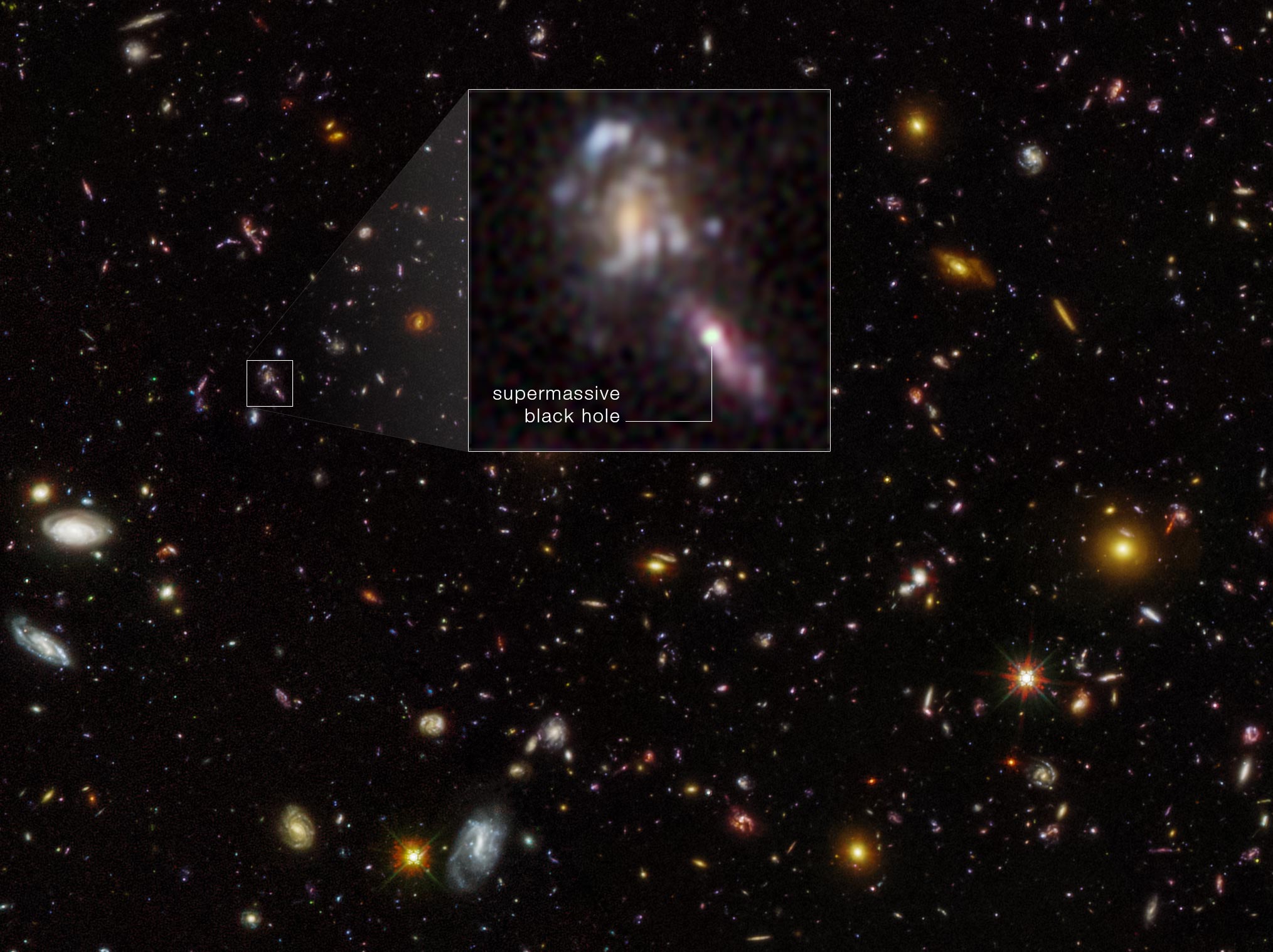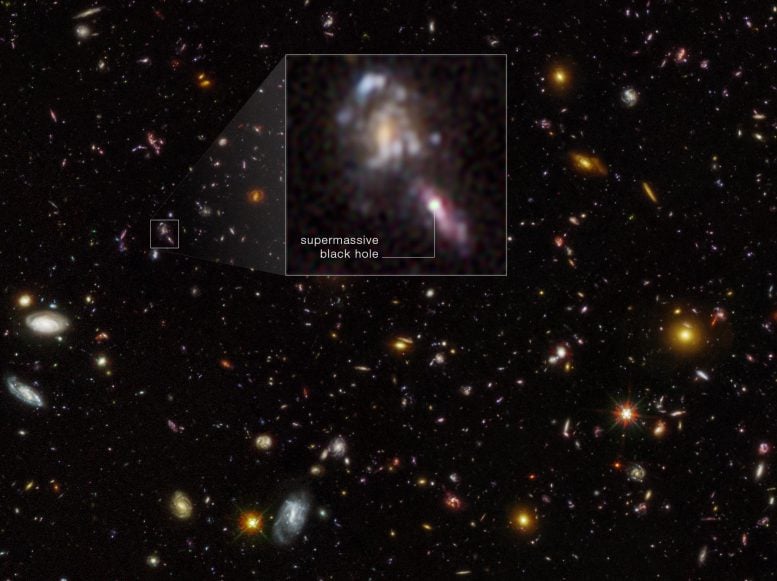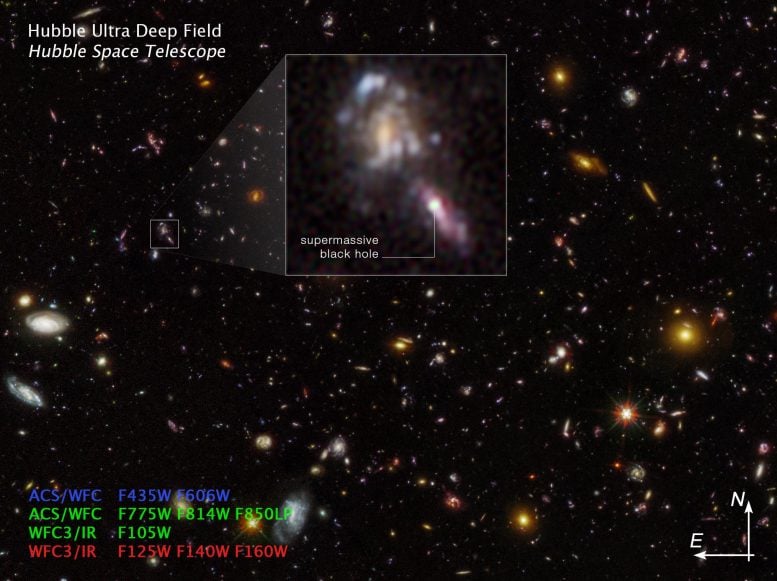

A Survey of Hubble’s Deepest Look Back into Time Uncovers New Clues
There seem to be countless black holes in the universe – space-time rabbit holes that forever swallow anything passing nearby. The most massive black holes, weighing millions or billions of times as much as our Sun, lurk in the centers of galaxies. When these sleeping dragons gobble up anything passing nearby they can blaze forth as bright lighthouses called active galactic nuclei. Other black holes do not pull in surrounding material constantly, but in fits and bursts, making their brightness flicker.
This behavior was used by astronomers to go black hole hunting. One of the best hunting grounds is the Hubble Ultra Deep Field – which unveiled faint galaxies that existed not long after the Big Bang. The Hubble Ultra Deep Field photo was revealed in 2004. A team of astronomers from Stockholm University looked at later images of the Hubble Ultra Deep Field and found changes in brightness among some galaxies. These changes are attributed to black hole variability – like flickering holiday lights. The result is that they found more black holes in the early universe than has previously been reported.
The relationship between early galaxies and massive black holes is a chicken-and-egg dilemma for cosmologists. What came first? Revisiting the extraordinary Hubble Ultra Deep Field offers new clues.

Credit: NASA, ESA, Joseph DePasquale (STScI)
Hubble Space Telescope Finds More Black Holes than Expected in the Early Universe
With the help of NASA’s Hubble Space Telescope, an international team of researchers led by scientists in the Department of Astronomy at Stockholm University has found more black holes in the early universe than has previously been reported. The new result can help scientists understand how supermassive black holes were created.
Currently, scientists do not have a complete picture of how the first black holes formed not long after the Big Bang. It is known that supermassive black holes, which can weigh more than a billion suns, exist at the center of several galaxies less than a billion years after the Big Bang.
“Many of these objects seem to be more massive than we originally thought they could be at such early times — either they formed very massive or they grew extremely quickly,” said Alice Young, a PhD student from Stockholm University and co-author of the study published in The Astrophysical Journal Letters.
Insights From Hubble’s Extended Observations
Black holes play an important role in the lifecycle of all galaxies, but there are major uncertainties in our understanding of how galaxies evolve. In order to gain a complete picture of the link between galaxy and black hole evolution, the researchers used Hubble to survey how many black holes exist among a population of faint galaxies when the universe was just a few percent of its current age.
Initial observations of the survey region were re-photographed by Hubble after several years. This allowed the team to measure variations in the brightness of galaxies. These variations are a telltale sign of black holes. The team identified more black holes than previously found by other methods.
New Theories on Black Hole Origins
The new observational results suggest that some black holes likely formed by the collapse of massive, pristine stars during the first billion years of cosmic time. These types of stars can only exist at very early times in the Universe, because later-generation stars are polluted by the remnants of stars that have already lived and died. Other alternatives for black hole formation include collapsing gas clouds, mergers of stars in massive clusters, and “primordial” black holes that formed (by physically speculative mechanisms) in the first few seconds after the Big Bang. With this new information about black hole formation, more accurate models of galaxy formation can be constructed.
Advancing Our Understanding of Cosmic Phenomena
“The formation mechanism of early black holes is an important part of the puzzle of galaxy evolution,” said Matthew Hayes from the Department of Astronomy at Stockholm University and lead author of the study. “Together with models for how black holes grow, galaxy evolution calculations can now be placed on a more physically motivated footing, with an accurate scheme for how black holes came into existence from collapsing massive stars.”
Future Research with James Webb Space Telescope
Astronomers are also making observations with NASA’s James Webb Space Telescope to search for galactic black holes that formed soon after the big bang, to understand how massive they were and where they were located.
Reference: “Glimmers in the Cosmic Dawn: A Census of the Youngest Supermassive Black Holes by Photometric Variability*” by Matthew J. Hayes, Jonathan C. Tan, Richard S. Ellis, Alice R. Young, Vieri Cammelli, Jasbir Singh, Axel Runnholm, Aayush Saxena, Ragnhild Lunnan, Benjamin W. Keller, Pierluigi Monaco, Nicolas Laporte and Jens Melinder, 6 August 2024, The Astrophysical Journal Letters.
DOI: 10.3847/2041-8213/ad63a7
The Hubble Space Telescope has been operating for over three decades and continues to make ground-breaking discoveries that shape our fundamental understanding of the universe. Hubble is a project of international cooperation between NASA and ESA (European Space Agency). NASA’s Goddard Space Flight Center in Greenbelt, Maryland, manages the telescope and mission operations. Lockheed Martin Space, based in Denver, Colorado, also supports mission operations at Goddard. The Space Telescope Science Institute in Baltimore, Maryland, which is operated by the Association of Universities for Research in Astronomy, conducts Hubble science operations for NASA.